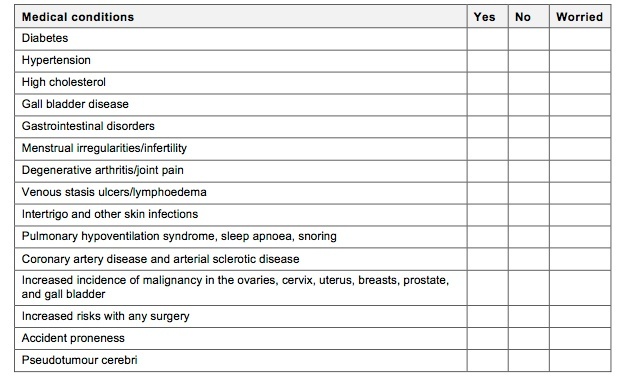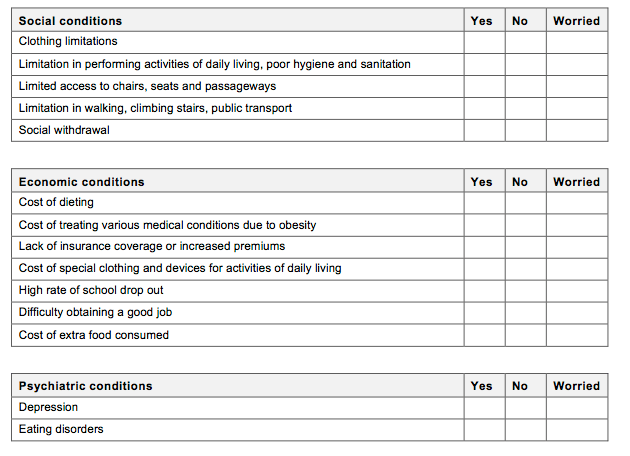Obesity is emerging as a health epidemic around the world. According to the Centres for Disease Control and Prevention, obesity is rapidly spreading across all regions and demographic groups. An estimated 97 million adults in the United States are overweight or obese. That figure represents more than 50% of the American adult population. Of this group, 11 million adults suffer from severe obesity.
Obesity is an excess of total body fat, which results from caloric intake that exceeds energy usage. A measurement used to assess health risks of obesity is Body Mass Index (BMI).
Click here to find out more about Body Mass Index BMI.
The American Obesity Association reports that obese individuals have a 50-100% increased risk of death as compared to normal weight individuals, with 300,000 to 587,000 deaths each year. This substantial increase in health risks has made obesity the second leading cause of preventable death in the United States.
What causes obesity?
This is a complex condition, and the causes and contributors are also complex. In order for obesity to occur in an individual, two factors need to occur:
- A genetic predisposition towards obesity. Some people have a greater risk than others, and this familial tendency is usually easy to observe
- A period or periods of calorie excess (where excess calories eaten are stored as fat). This can be associated with periods of reduced exercise
There is a misperception that weight loss is simply a matter of eating less for a while and doing some exercise. If this were true, obesity as a disease wouldn’t exist. (After all, who would choose to be obese if reversing the condition were simply a matter of eating less until you have ‘used up’ the extra calories you had eaten?) Unfortunately, obesity is irreversible. Once you have gained weight, and kept that weight on for a while, it becomes your new set-point weight (your normal weight). In order for someone to lose weight they need to eat less than most people they know, and unfortunately to keep that weight off they have to continue eating the same way. Someone wanting to lose weight permanently is facing a lifetime of eating far less that they are used to doing, and they have to sustain these eating habits in an environment where food is readily available and those around them are often eating more than they are, with seeming impunity.
Weight & Health
Obesity is associated with a number of medical and lifestyle complications. The number and severity of these complications are directly proportional to the severity and duration of obesity, and vary with the distribution of body fat.
What those excess kilos are doing to you
Most patients with morbid obesity (BMI greater than 40) suffer from at least one of the following conditions. Look at these lists and see if any of these problems apply to you. Losing weight will help you gain control of many of these. Most people seeking surgery are doing it as much to improve their health and quality of life as to shed kilos and reach a particular goal weight. Becoming healthy and being able to participate in normal activities are far more meaningful.
Figure 2. The yearly risk of death from all causes doubles at a BMI of 35 and rises considerably above this.


Your Choices
Non-Surgical Treatment
Dieting, exercise, and medication have long been regarded as the conventional methods to achieve weight loss. Sometimes, these efforts are successful in the short term. However, for people who are morbidly obese, the results rarely last. For many, this can translate into what’s called the “yo-yo syndrome,” where patients continually gain and lose weight with the possibility of serious psychological and health consequences. Recent research reveals that conventional methods of weight loss generally fail to produce permanent weight loss. Several studies have shown that patients on diets, exercise programs, or medication are able to lose approximately 10% of their body weight but tend to regain two-thirds of it within one year, and almost all of it within five years*. Another study found that less than 5% of patients in weight loss programs were able to maintain their reduced weight after five years *.
Surgical Treatment
Why perform surgery for morbid obesity?
Morbid obesity surgery is not cosmetic surgery. All doctors recognise that once a patient’s weight exceeds a certain range they are more likely to suffer from a wide range of illnesses such as diabetes, sleep apnoea, asthma, hypertension, arthritis, varicose veins and skin problems. Their chances of dying at a premature age are also greatly increased. Their employment prospects, mobility and social acceptance also suffer. Depression is much more common in the morbidly obese. The main aim of this surgery is to bring your weight down to a safer range where most of these associated conditions are reduced in severity and many completely reversed. Along the way most people find an improvement in their mobility, body image, self-esteem and enjoyment of life.
Surgery
Gastrointestinal surgery for obesity, also called bariatric surgery, change the normal digestive process. The operations promote weight loss by decreasing absorption of nutrients and there by reducing the calorie intake.
- Lapband Surgery
- Sleeve Gastrectomy
- Revision Bariatric Surgery


